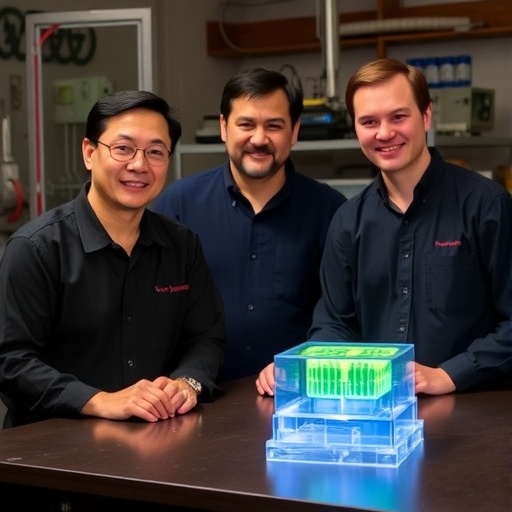In a groundbreaking advance that redefines our grasp of quantum light-matter interactions, researchers at Rice University have unveiled a revolutionary chiral photonic-crystal cavity that selectively enhances quantum vacuum fluctuations of circularly polarized light in one direction. This innovation breaks through a long-standing barrier in quantum optics and material science, where achieving such directional chirality traditionally demanded the use of strong magnetic fields, often impairing material characteristics and limiting practical application.
Vacuum, often misconstrued as absolute emptiness, is in reality a dynamic arena dominated by transient virtual particles, particularly photons, whose spontaneous and ephemeral manifestations engender tangible impacts on physical systems. Optical cavities—microscopic spaces bounded by highly reflective mirrors—have been instrumental in concentrating these quantum vacuum fluctuations to manipulate matter at fundamental levels. However, conventional cavities amplify fluctuations symmetrically for both right- and left-handed circular polarizations, lacking the ability to bias one over the other in absence of intense external magnetic influence.
The Rice-led research team, spearheaded by the pioneering physicist Junichiro Kono, has devised an ingenious cavity architecture integrating lightly doped indium antimonide, a semiconductor renowned for its exceptional infrared detection qualities. The photonic-crystal cavity constructed with this material introduces an unprecedented degree of control over vacuum fields, enabling a pronounced chirality with drastically diminished magnetic field demands—reducing the intensity required by an order of magnitude compared to earlier efforts. This feat not only enhances the feasibility of practical deployment but also preserves the pristine properties of materials housed within the cavity.
Underpinning this experimental breakthrough lies an intricate fusion of theoretical modeling and numerical simulation. By combining classical electromagnetic field mapping with quantum density functional theory and cavity quantum electrodynamics frameworks, the team forged a multiscale hybrid model capable of accurately forecasting how target materials respond to engineered vacuum fields. This comprehensive approach overcomes the limitations of previous models, which often treated light and matter interactions in isolation or under oversimplified assumptions.
Graphene, a single atomic layer of carbon atoms arranged in a flawless hexagonal lattice, emerged as the prime candidate material to demonstrate the cavity’s transformative efficacy. When introduced into the chiral cavity environment, graphene’s electronic band structure undergoes a remarkable modification: the normally gapless Dirac cones open a band gap, inducing a novel topological insulating state. This quantum phase transition could have profound implications for quantum computing, where such topological materials may enable more robust, fault-tolerant qubits and pave paths toward scalable quantum architectures.
Achieving this level of vacuum-mediated material transformation without resorting to cumbersome external controls, such as enormous magnetic fields or extreme temperatures, heralds a paradigm shift in quantum materials engineering. Instead of applying direct stimuli, scientists can now manipulate matter’s intrinsic properties simply by tailoring the quantum vacuum environment surrounding the material—a concept Kono terms "reshaping vacuum." This approach could revolutionize device fabrication by reducing complexity and enhancing material stability.
The intricate design of the cavity was optimized through extensive, cutting-edge computational simulations led by Alessandro Alabastri and Stephen Sanders, which accurately tuned the photonic-crystal layers to sustain long-lived, uniform circularly polarized vacuum fields. By circumventing the laborious and resource-intensive trial-and-error fabrication process, this simulation-driven methodology not only expedited the cavity’s development but also afforded unparalleled design flexibility, enabling exploration across vast parameter spaces for optimal performance.
At the heart of the chiral cavity’s operation is the delicately balanced interplay of charge carriers in the indium antimonide semiconductor. Their exceptionally low effective mass allows modest magnetic fields to selectively suppress vacuum fluctuations propagating in one direction, while leaving the opposite polarization largely unaffected. This finely tuned suppression imbues the cavity with a handedness that translates directly into asymmetric quantum interactions with embedded materials—a long-sought-after goal in photonic engineering and quantum electrodynamics.
This breakthrough carries transformative potential beyond graphene, as the constructed theoretical framework and cavity platform can be readily extended to diverse materials. Exploring how various quantum materials interact within chiral vacuum fields can unlock a new arsenal of engineered quantum phases and functionalities, with applications spanning from next-generation photonic devices to novel sensors and quantum simulators.
The implications of manipulating quantum vacuum fluctuations extend deeply into condensed matter and quantum optics research, offering tools to probe fundamental symmetries and topologies of matter. As outlined by theorists involved in the study, the engineered band gap in graphene is a manifestation of the interaction between chiral photons and electronic states inside the cavity, opening avenues to precisely engineer Dirac physics phenomena with light in ways previously unattainable.
Instrumental financial backing from the U.S. Army Research Office, the Gordon and Betty Moore Foundation, the Robert A. Welch Foundation, and the National Science Foundation enabled the convergence of cutting-edge experimental and theoretical efforts. The successful synthesis of theory, simulation, and experiment serves as a blueprint for multidisciplinary collaboration integral to advancing quantum technology frontiers.
Rice University’s Smalley-Curl Institute, under the stewardship of Kono who holds the Karl F. Hasselmann Professorship, continues to be a beacon for quantum materials innovation. This latest discovery epitomizes how reimagining the seemingly empty vacuum as an active participant in quantum engineering can lead to practical routes for developing novel quantum devices and technologies with unprecedented control, efficiency, and scalability.
As this research garners attention across the scientific community, it ignites fresh enthusiasm to further harness chiral quantum vacuum fields, inspiring future explorations where manipulating the quantum vacuum itself becomes a versatile tool. The fusion of photonics, semiconductor physics, and quantum theory in this study illuminates a bold path forward in the quest to architect matter at its most fundamental quantum level.
Subject of Research: Terahertz chiral photonic-crystal cavities and quantum vacuum engineering in graphene
Article Title: Terahertz chiral photonic-crystal cavities for Dirac gap engineering in graphene
News Publication Date: June 17, 2025
Web References:
References:
Fuyang Tay, Stephen Sanders, Andrey Baydin, Zhigang Song, Davis Welakuh, Alessandro Alabastri, Vasil Rokaj, Ceren Dag, and Junichiro Kono. "Terahertz chiral photonic-crystal cavities for Dirac gap engineering in graphene." Nature Communications, 2025. DOI: 10.1038/s41467-025-60335-x
Image Credits: Rice University / Nature Communications
Keywords
Quantum fluctuations, quantum matter, quantum states, graphene, chirality, photonics, light-matter interactions, cavity quantum electrodynamics




